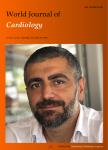Impact of cardiac magnet resonance imaging on management of ventricular septal rupture after acute myocardial infarction
Impact of cardiac magnet resonance imaging on management of ventricular septal rupture after acute myocardial infarction作者机构:Department of Radiology University Hospital Wuerzburg 97080 Wuerzburg Germany Department of Cardiothoracic and Thoracic Vascular Surgery University Hospital Wuerzburg 97080 Wuerzburg Germany Department of Internal Medicine I University Hospital Wuerzburg 97080 Wuerzburg Germany Department of Pediatric Radiology Institute of Radiology Medical University of Graz 8036 Graz Austria
出 版 物:《World Journal of Cardiology》 (世界心脏病学杂志(英文版)(电子版))
年 卷 期:2013年第5卷第5期
页 面:151-153页
学科分类:1002[医学-临床医学] 100201[医学-内科学(含:心血管病、血液病、呼吸系病、消化系病、内分泌与代谢病、肾病、风湿病、传染病)] 10[医学]
主 题:Cardiac magnetic resonance imaging Ventricular septal rupture Myocardial infarction surgical repair Extracorporeal membrane oxygenation
摘 要:A 74-year-old man was admitted to the cardiac catheterization laboratory with acute myocardial infarction. After successful angioplasty and stent implantation into the right coronary artery, he developed cardiogenic shock the following day. Echocardiography showed ventricular septal rupture. Cardiac magnet resonance imaging (MRI) was performed on the critically ill patient and provided detailed information on size and localization of the ruptured septum by the use of fast MRI sequences. Moreover, the MRI revealed that the ventricular septal rupture was within the myocardial infarction area, which was substantially larger than the rupture. As the patient s condition worsened, he was intubated and had intra-aortic balloon pump implanted, and extracorporeal membrane oxygenation was initiated. During the following days, the patient s situation improved, and surgical correction of the ventricular septal defect could successfully be performed. To the best of our knowledge, this case report is the first description of postinfarction ventricular septal rupture by the use of cardiac MRI in an intensive care patient with cardiogenic shock and subsequent successful surgical repair.



